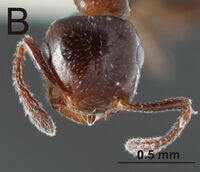Crematogaster khmerensis
| Crematogaster khmerensis | |
|---|---|

| |
| Scientific classification | |
| Kingdom: | Animalia |
| Phylum: | Arthropoda |
| Class: | Insecta |
| Order: | Hymenoptera |
| Family: | Formicidae |
| Subfamily: | Myrmicinae |
| Tribe: | Crematogastrini |
| Genus: | Crematogaster |
| Species group: | khmerensis |
| Species: | C. khmerensis |
| Binomial name | |
| Crematogaster khmerensis Hosoishi & Ogata, 2017 | |
Known only from the type material. The only biological information is a cryptic label note that suggests the specimens were collected in an arboreal sample.
Identification
Hosoishi and Ogata (2017) - Crematogaster khmerensis belongs to the subgenus Crematogaster sensu stricto (Blaimer 2012b). This particular small-sized species of Crematogaster (HW 0.6–0.66; WL 0.63–0.69) is similar to Crematogaster pfeifferi. These two species are readily distinguished from other Asian Crematogaster by the vertically directed propodeal spines and large propodeal spiracles. Crematogaster khmerensis is separated from C. pfeifferi by the propodeal spiracles touching metapleural gland bulla, short propodeal spines (PSL 0.08–0.09), petiole broader anteriorly than posteriorly and undeveloped subpetiolar process.
- Propodeal spiracles large and touching metapleural gland bulla. Petiole scoop shaped, broader anteriorly. Subpetiolar process undeveloped (Cambodia) . . . . . Crematogaster khmerensis
- Propodeal spiracles large and apart from metapleural gland bulla. Petiole elliptical with convex sides. Subpetiolar process developed acutely (Borneo) . . . . . Crematogaster pfeifferi
Distribution
Distribution based on Regional Taxon Lists
Oriental Region: Cambodia (type locality).
Distribution based on AntMaps
Distribution based on AntWeb specimens
Check data from AntWeb
Countries Occupied
| Number of countries occupied by this species based on AntWiki Regional Taxon Lists. In general, fewer countries occupied indicates a narrower range, while more countries indicates a more widespread species. |

|
Estimated Abundance
| Relative abundance based on number of AntMaps records per species (this species within the purple bar). Fewer records (to the left) indicates a less abundant/encountered species while more records (to the right) indicates more abundant/encountered species. |

|
Biology
Castes
Worker

| |
| . | |
Nomenclature
The following information is derived from Barry Bolton's Online Catalogue of the Ants of the World.
- khmerensis. Crematogaster khmerensis Hosoishi & Ogata, 2017: 9, figs. 4A-D (w.) CAMBODIA.
- Type-material: holotype worker, 3 paratype workers.
- Type-locality: holotype Cambodia: Kampong Thom Prov., 24.xi.2010, TUS arboreal SF3-1 (S. Hosoishi); paratypes with same data but SF3-3, SF3-6.
- Type-depositories: TNHM (holotype); BMNH, CASC, KUEC (paratypes).
- Distribution: Cambodia.
Unless otherwise noted the text for the remainder of this section is reported from the publication that includes the original description.
Description
Worker
HW 0.60–0.66; HL 0.60–0.67; CI 97–102; SL 0.43–0.50; SI 69–76; EL 0.14–0.15; PW 0.35–0.40; WL 0.63–0.69; PSL 0.08–0.09; PtL 0.22–0.23; PtW 0.20–0.25; PtH 0.12–0.14; PpL 0.12–0.14; PpW 0.20–0.23; PtHI 52–64; PtWI 87–114; PpWI 154–167; WI 92–100 (holotype and three paratype workers measured).
Workers presumably monomorphic. Head subquadrate in full-face view, with rounded posterior corners and subparallel sides. Occipital carinae developed. Mandible with four teeth, apical tooth large. Anterior margin of clypeus convex; anterolateral margins of clypeus protruded anteriorly; posterior margin of clypeus rounded between frontal lobes. Frontal carinae almost parallel. Antennae 11-segmented; antennal club 3-segmented. Scape reaching posterior corner of head. Basal flagellar segment (antennal segment III) as broad as long. Compound eyes slightly projecting beyond lateral margins of head in full face view. Pronotal shoulders angulate, but without distinct rugulae laterally. Mesonotal dorsum convex in lateral view. Pronotum and mesonotum not forming same dorsal outline in lateral view. Mesothoracic spiracle forms large pit concealed by posterior pronotal lobe. Metapleural gland opening slit-shaped. Propodeal spiracle large and circular, situated at posterolateral corners, touching metapleural gland bulla. Metanotal groove straight in dorsal view, deep and forming concave region between mesonotum and propodeum. In dorsal view, feeble longitudinal rugulae connecting between mesonotum and propodeum; the boundary distinct. Propodeal spines developed and directed vertically in lateral view.
Petiole scoop shaped, but flattened broader anteriorly, longer than broad; spiracle situated anteriorly midway between dorsal and ventral margin of petiole in lateral view, directed laterally. Subpetiolar process developed as a short lamellate denticle. Postpetiole without longitudinal median sulcus, but bilobed behind; spiracle situated anteriorly on lateral surface. Dorsal surface of head mostly smooth or weakly shagreened. Clypeus mostly smooth and shining. Pronotal collar areolately sculptured. Promesonotum weakly punctate. Lateral surface of pronotum smooth and shining. Mesopleuron mostly smooth and shining, but sculptured on surrounding area. Anterodorsal surface of propodeum weakly punctate; posteior half smooth and shining. Lateral surface of propodeum smooth and shining. Dorsal and lateral surfaces of petiole smooth and shining. Dorsal and lateral surfaces of postpetiole smooth and shining. Standing pilosity sparse. Dorsal face of head with appressed setae; one pair of erect setae on frontal lobes. Clypeus with one pair of erect setae. Anterior clypeal margin with two pairs of long setae mixed with short setae laterally. Scape with decumbent setae. Mesontum with appressed setae sparsely. Petiole with one pair of suberect setae posteriorly. Postpetiole with one pair of suberect setae posteriorly. Fourth abdominal tergite with short appressed setae sparsely. Body color brown.
Type Material
Holotype Cambodia: worker, Kampong Thom Province, 24 Nov. 2010, S. Hosoishi leg., (TUS arboreal SF3-1) (KUMANT040: deposited at Natural History Museum of the National Science Museum). Paratypes Cambodia: 3 workers, same locality data as for holotype (TUS arboreal SF3-3, TUS arboreal SF3-6)(KUMANT041: deposited at The Natural History Museum; KUMANT042: deposited at California Academy of Sciences; KUMANT043: deposited at Entomological Laboratory and Institute of Tropical Agriculture, Faculty of Agriculture, Kyushu University).
Etymology
The specific name refers to the former kingdom name of Cambodia, the Khmer Empire.

